July 2007
In continuation of a programme of archaeological research at Beacon Hill Wood, Shepton Mallet, further excavations were undertaken during the first week of July to investigate the remains and condition of two suspected prehistoric round barrows within the wood (see Figure 1). Under the guidance and direction of archaeological consultant Peter Leach, the project operates through the Beacon Hill Society, with the support of The Woodland Trust (owners), and the Somerset Aggregates Levy Support Fund. The project provides extensive opportunity for community involvement and the participation of local volunteers, including members of the Bath and Camerton Archaeological Society, Charterhouse Environs Research Team, Frome Local History Society, and students from Strode College, Street. Subsequent support for scientific analyses has come from the Maltwood Fund of the Somerset Archaeological and Natural History Society and through the Woodland Trust.
Trench 4
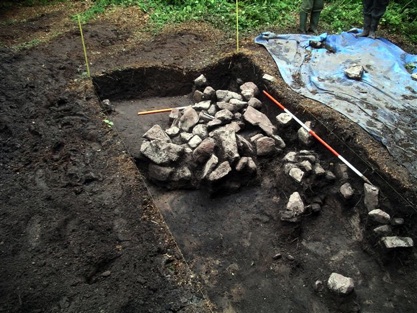
Both sites lie within the upper western part of the wood, close to the main track and the seat, and were damaged by tree planting over 50 years ago. The larger mound to the north has long been identified as a partly levelled round barrow mound surviving little more than 1m high and with a diameter of 17-18m (PRN 23062; Ashwick 5 – Grinsell’s Somerset Barrows catalogue 1971). Excavation of a 2m wide trench from its centre southwards (TRENCH 4, Figure 2) showed that the lower surviving part of the barrow was constructed of laid turfs set upon the remains of an organic-rich buried soil. This survived above clean weathered sand where protected by the mound, but any further investigation of these deposits or areas beyond the mound for features such as an outer ditch or satellite burials was hampered by exceptionally wet ground conditions.
Near the centre of the barrow a large flat-bottomed pit had been cut into its upper part and backfilled with many large blocks of the local Beacon Hill sandstone. Despite extensive disturbance from earlier forestry ploughing and animal burrowing, a small intact pit at its base contained a decorated pottery funerary urn of Middle Bronze Age type, sealed by a large flat sandstone slab.
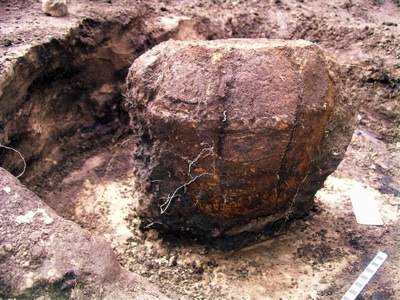
This vessel was carefully lifted as a soil block to keep it intact, and was transported to the laboratories of Wessex Archaeology Ltd at Salisbury, for detailed dissection, analysis of its components and reporting by their team of specialists, which is now completed (Urn Report and Urn Reconstruction Drawing). The pottery burial urn was a coarse, bucket-shaped jar surviving 220mm high and with a rim diameter of approximately 180mm, although the rim was degraded through pressure from the sandstone capping slab. Although complete, the vessel was fragmented – probably after its deposition – being of a coarse, poorly fired fabric, tempered with grog (ground pottery/fired clay fragments) and decorated with simple applied, finger-impressed cordons, one on the shoulder and four vertical strips extending up to the rim. This is identified as a vessel in the Middle Bronze Age Deverell-Rimbury tradition, found commonly in the Wessex region, and compares closely with pottery from Dorset and more locally from the Tadley Acres development site at Shepton Mallet.
Within the urn were over 500g of cremated human bone representing the probable remains of a young woman aged between 18 and 25. There was no evidence of anything accompanying her, although remains of the funeral pyre survived within and around the top of the urn, deposited immediately after it had been set into the base of a shallow pit cut into the earlier round barrow mound and then sealed by a freshly quarried slab of local sandstone. Analysis of the pyre material suggests that the cremation ceremony probably took place close by, using mainly oak wood for a hotter fire, with some hazel, woody shrubs and grass roots as kindling. The remainder of the shallow burial pit had then been filled by a dump of tumbled sandstone blocks.
The pottery urn has already identified this as a burial of Middle Bronze Age date, but completion of its processing has allowed a small sample of the cremated bone to be submitted for Radio Carbon dating to a laboratory in Scotland. A date around 1400 BC might be expected but the result should be available by March of this year. The next step is to commission a restoration of the pot to preserve it and facilitate its future display. This will eventually be in the new County Museum at Taunton but it is hoped to arrange for its display more locally in the meantime.
Research is also underway into the local contemporary environment, as reflected by samples taken for pollen identification. The acid soils of Beacon Hill preserve this form of evidence well, and samples taken from the barrow mound material and a buried soil deposit beneath it are currently being analysed at the University of the West of England in Bristol. It was apparent during the excavation that the barrow was built largely of turfs, almost certainly cut locally, rather than with the upcast from any surrounding ditch. Analysis of the pollen from these should give a good impression of the local vegetation and environment of this part of Mendip when the barrow was built, although this was probably several centuries before the cremation burial was made.
Trench 5
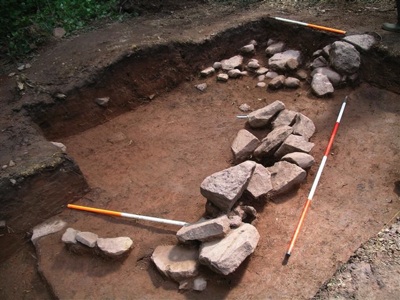
Less than 100m to the south a second trench was excavated to investigate a low mound claimed by previous researchers as the site of another prehistoric round barrow (PRN 23063, TRENCH 5, Figure 3). In the event no such evidence was found, but instead were located two alignments of tumbled stone blocks set at right angles, within which were thin spreads of charcoal and scattered worn stones indicating a floor level. This was associated with occasional sherds of coarse Roman pottery, some iron nails and shoe hobnails. The stone alignments suggest two sides of a rectangular building of unknown full extent, possibly acting as supports for timber uprights, all trace of which had vanished.
This unexpected discovery is best interpreted as evidence for occupation on the hill during the Roman period, probably associated with the stone-working quarries whose remains are still preserved within the woodland. The latter have been the subject of previous archaeological excavation sampling as part of this project, along with attempts to locate and characterise the Roman Fosse Way road that passes through the wood.
Much has already been learned through these discoveries, but even the completion of ongoing work should not be the end of the story. The cremation discovered in 2007 had been inserted into the top of an earlier barrow, in all probability only one of a small contemporary cemetery of such burials located on and around the barrow. There is no current necessity to find or excavate these, but the barrow itself deserves further exploration. The exceptionally poor summer of 2007 restricted the scope of our excavations then, but with the continued backing of the Woodland Trust, financial grants, and above all the commitment and enthusiasm of our local community volunteers and societies, another season of excavation is proposed. The absence of evidence for later excavation of the barrow argues in favour of the survival of a primary burial in the centre of the mound, at or below the original ground level. An attempt to locate this, in tandem with more research on the barrow mound and the contemporary environment, would be worthy objectives for fieldwork in 2008.
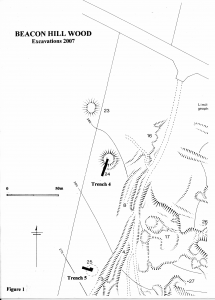
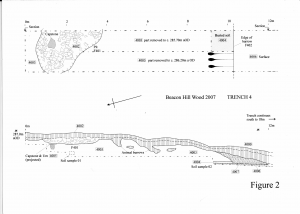
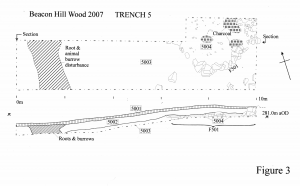
Peter Leach, January 2008
Further Information
Full report, by Wessex Archaeology Ltd, on the contents of the bronze age urn found in 2007 and sectional drawing of the urn.
Radiocarbon dating analysis reports on the contents of the urn and charcoal heather.
Report on the pollen analysis of soil materials recovered during excavation.